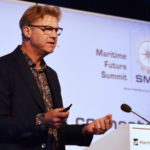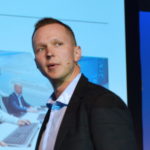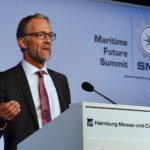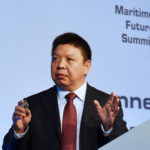The Maritime Future Summit of HANSA and SMM asked what the future might look like. The event titled »Mind the gap – bridging disruptive technologies« showed that the industry’s progressive thinkers have partly unexpected, partly unanimous answers, reports Felix Selzer
Encouraged by the response to the first Maritime Future Summit in 2016, Hamburg Messe & Congress (HMC) and HANSA organized the[ds_preview] kick-off event to the SMM trade show once again. While the first-ever summit held in 2016 was about »smart everything – smart ships, smart ports, smart supply industries etc.«, as moderator Volker Bertram of World Maritime University put it, this new summit was much more about getting business models and business processes digitized or ready for digitization in the first place. About 150 delegates joined the conference, surpassing the number of guests two years ago.
Hubert Hoffmann, CIO and CDO of MSC Germany kicked of the MFS with his keynote speech »New thinking in shipping – a liner company’s perspective«. The world’s second biggest container shipping company is looking into ways to increase efficiency by coming up with own approaches and solutions to digitization. The industry has always been lagging behind former industrial transformations – when steam energy was used on land, ships had sails, when electricity powered factories and homes, shipping used steam engines etc. »With the container we are finally on the same level as the digitized outside world, using standardized units, just like bits and bytes,« Hoffmann said – an ideal starting point for digitization.
»It’s not about hardware or software«, Mark O’Neil, CEO of ship management giant Columbia Marlow Holding said when speaking about »Digitization in fleet operations« from a ship manager’s perspective. »It’s about the intersection between technology, innovation and processes.« As O’Neil put it, digitization is a path rather than a finite process. For the ship manager, best practises are key: »Don’t digitize inefficient processes. If your business is inefficient, it will also be with the latest software.« Columbia Marlow has partnered with German airline Lufthansa to identify and establish best practises for digitization.
In Hoffmann’s view, the gap that needs to be bridged lies in the utilization of assets. To achieve this, the processes have to be reviewed to be able to truly digitize them. »Mind the gap in your mind,« he said. The solution is not moving B2B processes to digital channels but in decoupling information sharing and business processes of partners (e.g. via cloud architecture). »Without that, even the autonomous vessel doesn’t really offer anything new.«
Bridging the gap in the minds of many industry players is also the concern of Ulf Siwe from Swedish maritime administration. Siwe was promoting the Sea Traffic Management project that has already introduced a global standard for exchanging route information between vessels and ports to enable interoperability. A number of ships are already using it in a validation project. Next steps would be port collaboration and ship reporting. Siwe understands the concerns when it comes to sharing data and losing possible competitive advantages, concerns that have to be addressed in the development of information sharing schemes. Sharing information with authorities can significantly increase safety and efficiency, e.g. by importing pilot routes or ice information into a ship’s voyage plan. »Today, we can put all the players on the same level of knowledge.« Sharing data such as arrival times could lead to less fuel consumption, less emissions, improved safety with 70% fewer groundings and collisions.
Sea traffic management is a good example for an area where shipping seems to lag behind. Moreover, many industries also have interesting new solutions – that might not even have relevance for shipping, yet. But the National Maritime Research Institute of Japan (NMRI) has looked into 116 technologies inside and outside of shipping and what their impact on maritime could probably be by 2050. Kohei Matsuo presented the impressive Japanese »Technology Roadmap«, covering new materials, manufacturing and design methods as well as IT solutions, energy sources and logistics processes. He foresees composite materials as the new normal, while Augmented and Virtual Reality open up new perspectives in design and allow outsiders to provide valuable input. 3D printing is seen as a means to overcome place constraints in manufacturing of components. The boldest vision maybe is the »direct download to brain« of information by using human interfaces to bridge the gap between the real world and the digital world. Would this be a way to change mind-set through technology?
Pierre Sames, Director of Maritime Technology at DNV GL looked into »Technical assurance 2030«, seeing Digital Twins of ships and other assets and Artificial Intelligence coming into broad use as computing power increases massively: 1000-fold every four years. Connected devices in the Internet of Things (IoT) such as sensors and mobile devices are predicted to quadruple in number by 2025. »This will allow to automate support processes, change the delivery mode of existing
services and ultimately enable entirely new services,« Sames said. But »who will pay for the Digital Twin?« he asked, as different players all hold pieces of the puzzle that they do not want to share. That is why DNV GL and partners have started an open simulation platform initiative to establish a safe eco-system.
Connecting humans and sea assets
Mikko Lepistö, Director of Software and Automation Operations at ABB promoted the electric ship as the solution to many of the aforementioned problems from a technical perspective. While battery solutions have already proven feasible for smaller ships, ABB with partner Ballard is developing MW-sized fuel cell solutions for larger units. »Electric means more efficient, simpler, flexible, more digital and better integrated«, Lepistö said. He is convinced that the industry is not using the full potential of today’s solutions as they are rarely fully integrated. In his view, electrification is the key to unlocking the potential in all areas of maritime operations. »Electric systems allow for digitization which in turn allows for new services such as collaborative operations with manufacturers providing remote support, reducing transaction costs and avoiding down times«, he said. »It’s about connecting the human in the loop and the assets at sea.«
With advanced automation and Artificial Intelligence taking over, new questions arise. Wu Sun of China Classification Society (CCS) looked into the field of legislation and liability of autonomous shipping. There are different degrees of automation in that process, ships with automated systems, remote controlled ships with crew, without crew and fully autonomous. While the first two, from a liability point of view, are more or less feasible today, the latter two need to deal with changes in liability. »Who is liable in an autonomous ship accident – the maker of the systems, the owner, the operator? And don’t forget that cyber risks need new insurance products.« In the end, the question for liability is directly linked to data ownership and responsibilities for data integrity in a future connected multi-user environment. What data can and should be shared, and how to do it?
Specialists win in new world
The technical solutions might also have an effect on how acompany structures will look like. Will it still be efficient to have capabilities in every aspect of a business when everybody is connecting services? Christian Roeloffs, Managing Director of Container xChange, much like MSC’s Hoffmann sees business collaboration via centralized platforms, cloud solutions or blockchain as the future. »Expect to see more specialized companies and services again,« he said, »it makes no sense to keep such very different sectors like container shipping and container equipment operations under one roof.« According to him, the way to win in the future might be to specialize, concentrate on core strengths and get rid of marginal business. »On the loser side there will be conglomerates who can play on all fields but are no experts anywhere.« Shipping should prepare for an eco-system future.
Nick Danese, CEO of NDAR called on the shipbuilding industry to wake up and share information to use the full potential of swarm intelligence: »To be effective, efficient and productive, people have to know what they are doing, so we have to give them information.« He has the vision of information hubs that distribute information by demand. »It will change, when everybody can take responsibility and request the data that they need for their work.« According to him this is key to ensure that today’s investments are still right ten years later.
Time is tight, right?
To emphasize the urgency of a transformation, Mark O’Neil said: »Operators need to achieve OPEX savings of 25 to 30% over the next five years to stay relevant and competitive.« This would only be possible by applying new solutions and At the same time, he warned not to be to hasty with digitization: »Making the right move at the slightly wrong time is better than making the wrong move. Nothing is more disruptive than implementing the wrong IT solution.« He thinks that many big players are not that far ahead with their digitization processes – if they are ahead at all – but are rather just integrating legacy systems. »There is time. Your vision and your agenda are vital.« Companies should identify existing and future markets and strive for compatibility with the market.
With this year’s SMM motto »Trends in SMMart shipping« in mind, the Maritime Future Summit of 2016 was ahead of its time, being about »smart everything«. SMM 2020 will show, if the summit was able to set the course again. It certainly provided good guidance into the future of shipping. The challenge to get to this future really doesn’t seem to be about technology anymore. Cloud, blockchain, broadband connectivity, situational awareness, various monitoring and automation solutions, analytics etc. – it’s all there. The bigger challenge seems to be changing culture. Hoffman used a quote from economist Peter Drucker, to illustrate the situation: »Culture eats strategy for breakfast.« In fact, in can be said that digitization in a (business-) world of locked-up silos isn’t worth much. Digitization needs cooperation to unlock the potentials and cooperation needs digitization to work effectively and efficiently. This is the cultural change required, the potential is huge, according to Ulf Siwe: »Shipping carries 90% of goods worldwide, imagine the global impact that digitized solutions from this industry have.«
Felix Selzer


























